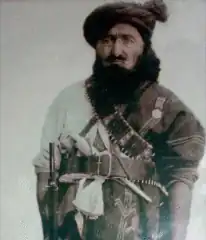Babrak Khan
Babrak Khan | |
|---|---|
| ببرک خان ځدراڼ | |
 | |
| Tribal chief of the Zadran tribe | |
| In office unknown – October 1924 | |
| Preceded by | unknown |
| Succeeded by | Mazrak Zadran |
| Personal details | |
| Born | Almara[1] |
| Died | October 1924 Bak, Southern Province, Emirate of Afghanistan |
| Children | Mazrak Zadran Sher Muhd Khan Said Akbar Babrak Izmair 5 or 14 others |
| Parent |
|
| Siblings | Khan Muhammad |
| Tribe | Zadran |
| Military service | |
| Allegiance | Emirate of Afghanistan |
| Battles/wars | Khost rebellion (1912) Third Anglo-Afghan War Khost rebellion (1924–1925) |
Babrak Khan (Pahsto: ببرک خان ځدراڼ; died October 1924) was a Zadran chieftain who was the father of Said Akbar Babrak (assassin of the first Prime Minister of Pakistan, Liaqat Ali Khan) and of Mazrak Zadran (a rebel leader during the Afghan tribal revolts of 1944–1947).
He died fighting rebels during the Khost rebellion (1924–1925).
Biography
Early life
Babrak Khan born in Almara.[1] He was the son of Mazar Khan (Pashto: مزرک خان).[1] Babrak spent most of his early life in poverty.[1]
Chieftain

In 1898, Babrak had under him five companies of Zadran Khasadars, whom he maintained on a contract system with emir Abdur Rahman Khan, but these were subsequently disbanded and their place taken by regular troops. According to Ludwig Adamec, he took part in quelling the Khost rebellion of 1912,[2] even though the Zadran tribe (which he was supposedly chief of) was fighting against the Afghan government, according to the Britannica Year book 1913.[3] Zadrans burnt his tower in 1913. In 1917, he headed a deputation of leading Zadran Maliks which visited the Nazim of Khost with a view to making peace with the British. He also tried to restrain Zadrans from troubling the Tochi border.[2] In March 1919, Babrak left for Kabul with Sayyid Musa Shah Mandozai to offer allegiance to Amanullah Khan. In May, he despatched messengers to Miranshah and Sherani to summon Maliks.[2] During the Third Anglo-Afghan War, he accompanied the Afghan Army as far as Matun and was said to have participated in Nadir Khan's attack on Thal. For his efforts in the war, he was promoted to honorary Brigadier and Naib Salar.[2]
Death and succession
In the context of the Khost rebellion, on 22 October 1924, it was reported that Babrak Khan had "recently" died fighting rebels at the village of Bak.[4] He was succeeded as chieftain by his son, Mazrak.[5]
Family
| Mazar Khan[6] fl. late 19th century | |||||||||||||||||||||||||||||||||||||
d. October 1924 | Khan Muhammad[7] | ||||||||||||||||||||||||||||||||||||
| Mazrak Zadran fl. 1900s – 1972 | Sayyid Akbar Babrak[8] b. 1921 or 1922 d. 16 Oct 1951 | Sher Muhd Khan[9] fl. 1924 – 1947 | Izmair[10] fl. 1924 – 1945 | 5 or 14 others[note 1] | |||||||||||||||||||||||||||||||||
| Dilawar Khan[14] b. 1939 or 1940 | Muhammad Umar Babrakzai[note 2] fl. 1980 | ||||||||||||||||||||||||||||||||||||
- ^ Sources disagree how many sons Babrak had - Jamna Das Akhtar states that Babrak had 18 sons,[11] while a Pakistani government inquiry titled The Assassination of Mr. Liaquat Ali Khan states that Babrak had 9 sons.[12] David B. Edwards states that Babrak had 2 sons,[13] but this appears to be false, as at least 4 of his son's names are known.
- ^ Muhammad Umar Babrakzai was Babrak Khan's grandchild[15] although it's unclear through what father.
References
- ^ a b c d "ببرک خان ځدراڼ/صفيه حليم". www.dawatmedia24.com/ (in Pashto). Archived from the original on 2019-09-22. Retrieved 2020-03-11.
- ^ a b c d Adamec, Ludwig W. (1975). Historical and Political Who's who of Afghanistan (PDF). Akademische Druck- u. Verlagsanstalt. p. 130. ISBN 978-3-201-00921-8.
- ^ The Encyclopaedia Britannica: A Dictionary of Arts, Sciences, Literature & General Information; the Three New Supplementary Volumes Constituting with the Volumes of the Latest Standard Edition, the Thirteenth Edition. Encyclopaedia Britannica, Company, Limited. 1926. p. 46.
- ^ Lilly, A. (10 November 1924). "Military Attaché, Britich Legation, Kabul's, Diary no. 42, for the Week ending November 7, 1924". India Office.
- ^ Fetherling, George (2011-11-16). "AKBAR, Said". The Book of Assassins. Random House of Canada. ISBN 978-0-307-36909-3.
- ^ "ببرک خان ځدراڼ/صفيه حليم". dawatmedia24. 18 August 2019. Retrieved 19 March 2020.
- ^ Adamec, Ludwig W. (1975). Historical and Political Who's who of Afghanistan (PDF). Akademische Druck- u. Verlagsanstalt. p. 130. ISBN 978-3-201-00921-8.
- ^ Fetherling, George (2011-11-16). "AKBAR, Said". The Book of Assassins. Random House of Canada. ISBN 978-0-307-36909-3.
- ^ Yapp, Malcolm (2001). British documents on foreign affairs: reports and papers from the foreign office confidential print. From 1946 through 1950. Near and Middle-East 1947. Afghanistan, Persia and Turkey, january 1947-december 1947. University Publications of America. p. 109. ISBN 978-1-55655-765-1.
- ^ https://web.archive.org/web/20041217215440/http://www.icdc.com/~paulwolf/pakistan/pakintrigue.htm
- ^ Akhtar, Jamna Das (1969). Political conspiracies in Pakistan: Liaquat Ali's murder to Ayub Khan's exit. Punjabi Pustak Bhandar. p. 224.
- ^ The Assassination of Mr. Liaquat Ali Khan: Report of the Commission of Enquiry. Manager of Publications. 1952. p. 11.
- ^ Edwards, David B. (2002-04-02). Before Taliban: Genealogies of the Afghan Jihad. University of California Press. p. 329. ISBN 978-0-520-22861-0.
- ^ Zaidi, Syed (2010). "The Assassination of the Prime Minister Liaquat Ali Khan: The Fateful Journey" (PDF). nihcr.edu.pk. p. 81.
Dilawar Khan was eleven years old boy. He was the son of Said Akbar, the alleged assassin
- ^ Brown, Vahid; Rassler, Don (2013). Fountainhead of Jihad: The Haqqani Nexus, 1973-2012. Oxford University Press. p. 56. ISBN 978-0-19-932798-0.